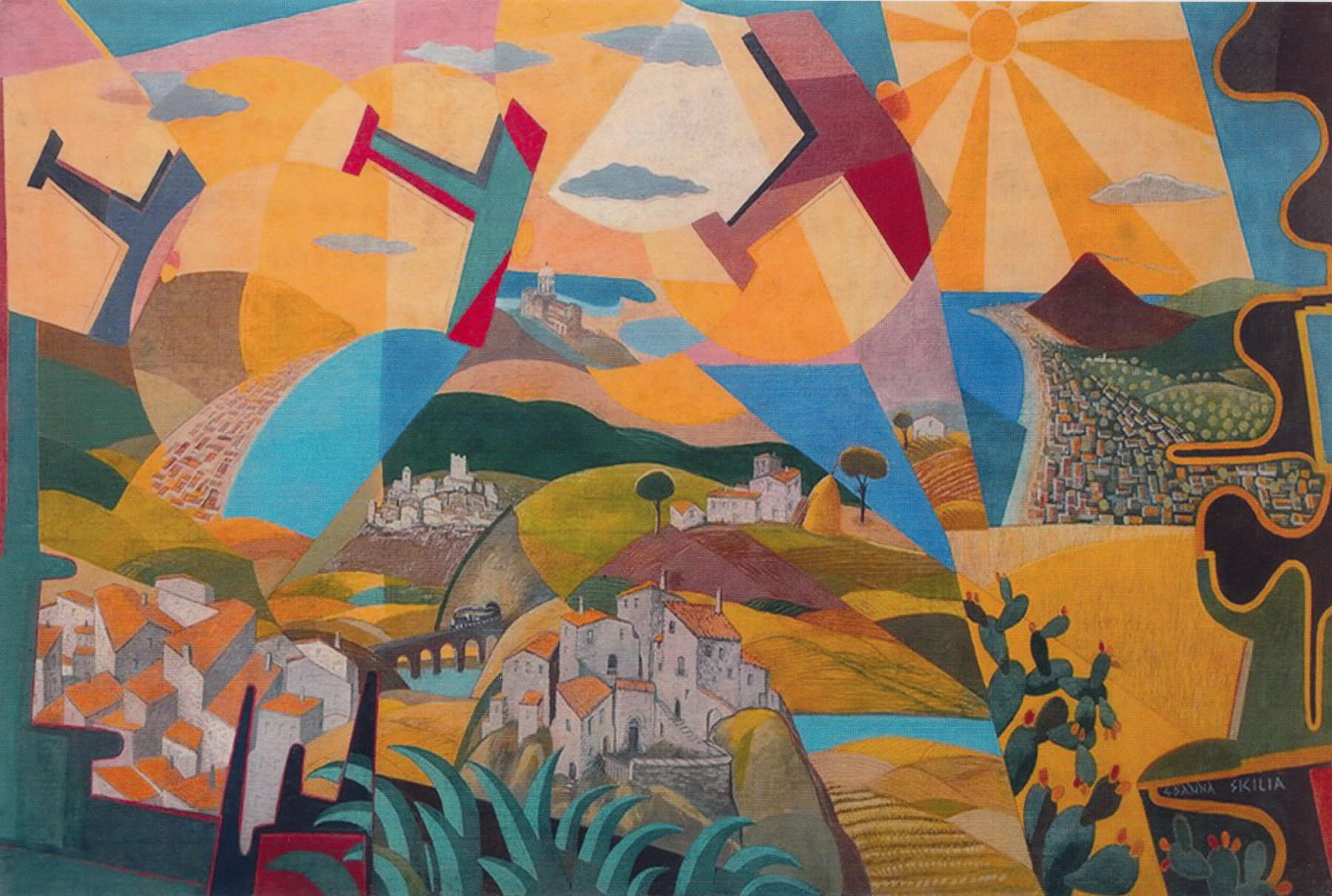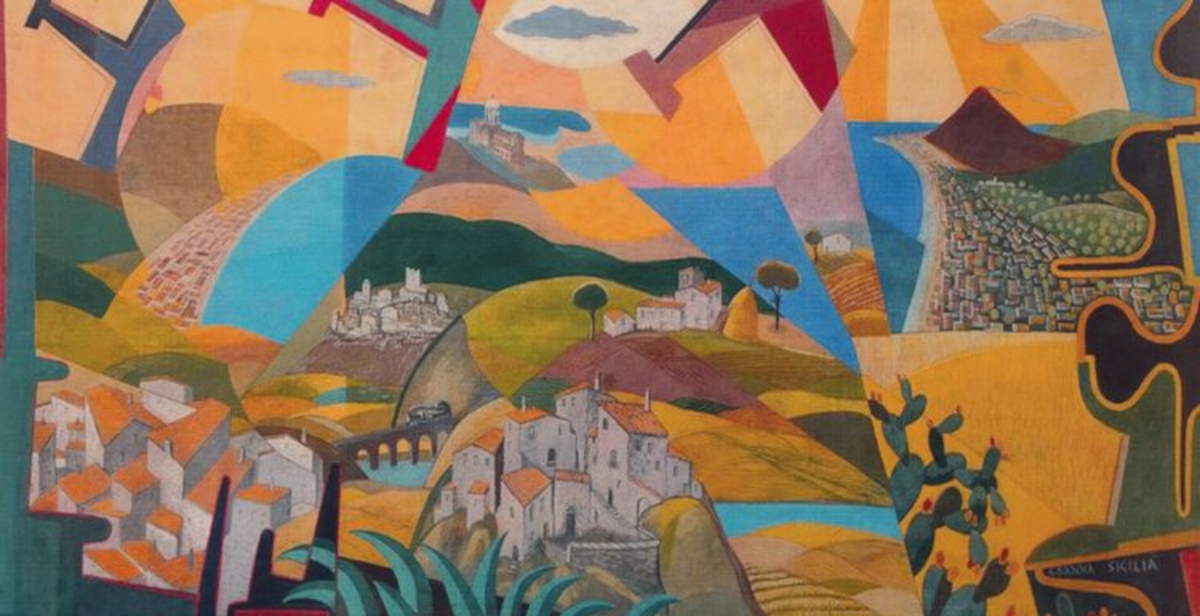Futurism lands in Sicily in Centuripe with an exhibition that investigates a rarely explored chapter of the Marinettian avant-garde: the Sicilian declination of the movement. Beginning Saturday, June 21, 2025, and running through Nov. 4, the Antiquarium Exhibition Center will host FUTURISM and SICILIAN FUTURISTS, an exhibition curated by Simona Bartolena and sponsored by the Department of Cultural Heritage and Sicilian Identity and the Municipality of Centuripe. The exhibition project was created with the intention of telling how, even in a reality apparently peripheral to the great centers of modern art, Futurism found fertile ground for experimentation, languages and personal paths. Indeed, the exhibition aims to restore Sicily to an active role in the history of the movement, highlighting the contribution of island artists often forgotten or neglected by official historiography.
“Surprising is the substantial marginalization from the ’great history of art’ to which critics have condemned this second phase of Futurism,” notes curator Simona Bartolena. “The controversial relationship with the fascist regime, often simplified or misunderstood, also contributed to this exclusion. Precisely with a view to its re-evaluation and greater clarity of analysis, with this itinerary we wish to recount above all the second phase of the Futurist Avant-Garde, the lesser-known one, rediscovering, in addition to the greatprotagonists, some less famous exponents, surprising in terms of personality and originality of language.”
Alongside the best-known protagonists of Italian Futurism, such as Umberto Boccioni, Giacomo Balla and Fortunato Depero, the exhibition brings to the foreground figures such as Giulio D’Anna, Pippo Rizzo and Vittorio Corona, among the main exponents of what was called the “Palermo school.” Some 40 paintings, mostly from private Italian collections and rarely seen by the public, make up the display, offering a broad overview of the movement and its evolutions, both nationally and locally. The exhibition is divided into thematic sections designed to highlight the phases and transformations of Futurism from 1909, when the first Manifesto was published in Le Figaro, to the 1930s. The itinerary opens with a survey of the origins, presenting works by Boccioni, Russolo, Balla and Roberto Iras Baldessari. The ideological and social context that accompanied the birth of the movement is thus reconstructed, in a historical moment traversed by tensions that would lead to the First World War. Art, according to Marinetti, was to be not only aesthetic expression but also an engine of change and collective reflection. The desire to reject “passatism” and to affirm a new vision of reality thus became the guiding principle of early Futurism.

One section is devoted to abstractionist tendencies in Italian production, often little investigated in historical analyses of Futurism. The selected works show how, even in the Italian context, the movement dialogued with European abstractionism, elaborating its own visual grammar focused on light, movement and geometric forms. Prominent among the works presented are those of Balla, which demonstrate a progressive dissolution of the figure and a tendency toward purity of form. The center of the exhibition is occupied by the theme of speed, dynamism and simultaneity. Here the distinctive features of the Futurist language emerge strongly, particularly the desire to overcome classical perspective and place the viewer at the center of the work. According to Boccioni, space was no longer to be conceived as fixed or delimited, but as fluid and constantly becoming. The compositions on display reveal the intent to represent reality in its mutability through an innovative use of color and line. The exhibition continues with a section that explores the extension of Futurism beyond the visual arts. The Manifesto of the Futurist Reconstruction of the Universe, signed by Balla and Depero in 1915, becomes the starting point for a reflection on the contamination between disciplines. Indeed, the Futurist movement engaged in numerous fields, including design, theater, dance, music, advertising, and applied art.
The 1930s represented another important phase of the movement. Although marginalized by the official artistic currents and partly obscured by the political climate of the time, Futurism was able to renew itself. Thus were born Aerofuturism, linked to the myth of flight and modernity, and Cosmic Futurism, characterized by openings toward the spiritual and esoteric dimensions. The exhibition includes works by Gerardo Dottori, Tullio Crali, Fillia, Thayaht and Enrico Prampolini, testifying to the vitality and complexity of this second season of Futurism, now the subject of renewed critical interest. Closing the itinerary, the section entirely devoted to Sicilian Futurists represents a moment of particular note. Pippo Rizzo, Giulio D’Anna and Vittorio Corona are among the central figures, capable of elaborating a personal language from the models proposed by the avant-garde. Between 1927 and 1929, the Palermo group also imposed itself internationally, but many of its exponents chose to remain on the island, contributing with their work to the growth of a local artistic identity, nurtured by the strength of the Sicilian cultural context.
 |
| Futurism and Sicilian masters on display in Centuripe: Balla, Boccioni, Depero and others |
Warning: the translation into English of the original Italian article was created using automatic tools. We undertake to review all articles, but we do not guarantee the total absence of inaccuracies in the translation due to the program. You can find the original by clicking on the ITA button. If you find any mistake,please contact us.